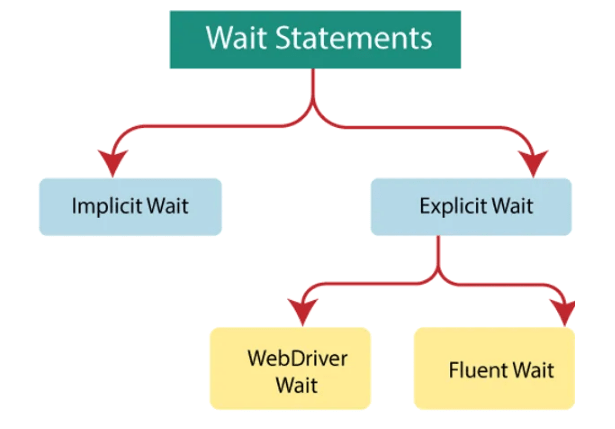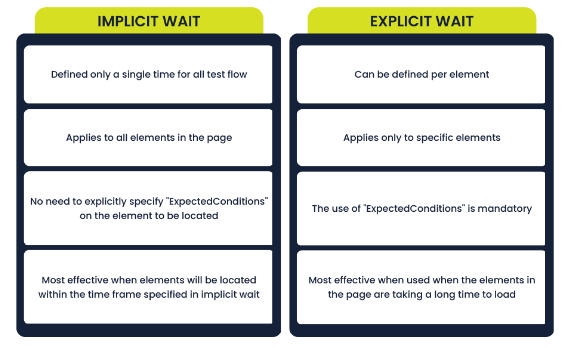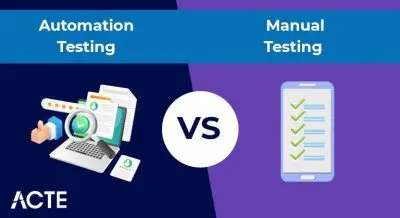
- Introduction to Fluent Wait
- What is Wait in Selenium?
- Why Do We Need Waits?
- Types of Waits in Selenium
- How Fluent Wait Works Internally
- Key Methods Used in Fluent Wait
- Fluent Wait vs Explicit Wait
- Conclusion
Introduction to Fluent Wait
Fluent Wait is a class in Selenium WebDriver that offers flexible waiting capabilities for test automation. Unlike fixed waits, Fluent Wait allows you to specify a maximum timeout period, how often to check for a condition, and which exceptions to ignore during the wait. This gives you much more control over how your tests handle dynamic web elements. One important feature of Fluent Wait is the ability to set custom timeout values. This means you can define the total time Selenium should wait for a particular element or condition to be met before failing the test. Along with this, you can set polling intervals, which determine how frequently the wait checks if the condition has been satisfied. Instead of waiting the full time blindly, Fluent Wait checks regularly, which helps your test proceed as soon as the element is ready. Another advantage is the ability to ignore specific exceptions during the waiting period. This is useful when elements are not immediately available or visible, and errors like NoSuchElementException can be safely skipped until the element appears or the condition is fulfilled. Fluent Wait provides greater control compared to other waits, making it suitable for handling web pages where elements load at different speeds or appear unpredictably. For example, if you want to wait for a login button to become clickable, you can set Fluent Wait to check every second for up to 30 seconds. This way, your test won’t waste time waiting longer than necessary and will act quickly when the button is ready. In summary, Fluent Wait improves the efficiency and reliability of automation scripts by enabling customized waiting strategies that better fit real-world web application behavior.
Are You Interested in Learning More About Software Testing? Sign Up For Our Software Testing Training Course Today!
What is Wait in Selenium?
In Selenium, a Wait is a fundamental mechanism used to synchronize the execution of test scripts with the behavior of the web application. Since web pages often take varying amounts of time to load elements or respond to user actions, waits help prevent errors caused by the script attempting to interact with elements that are not yet present or ready. Without waits, tests can become unreliable and fail unexpectedly, making waits an essential part of creating stable automation. Waits instruct WebDriver to pause the execution of a test script until a specific condition is met. These conditions could include waiting for an element to become visible, clickable, or present in the Document Object Model (DOM). By incorporating waits, tests become more robust because they account for delays in loading or rendering that are common in modern web applications.

For instance, imagine a scenario where a login button appears on the page after some processing that takes around 10 seconds. If your test script immediately tries to click this button without waiting, it will fail because the element does not exist yet in the page. A wait mechanism will hold the execution until the button becomes available, ensuring the interaction happens smoothly. Selenium offers different types of waits such as implicit wait, explicit wait, and fluent wait. Each type provides varying degrees of control over how long the WebDriver should wait and under what conditions. Understanding and using these waits effectively is critical for building reliable, efficient test automation scripts that can handle real-world web application behaviors without frequent failures. In summary, waits play a key role in making Selenium tests stable by managing the timing between script execution and application response.
Why Do We Need Waits?
- Asynchronous Content Loading: Modern web applications frequently load content asynchronously using JavaScript, AJAX, or delayed rendering. This means that while a page may appear fully loaded visually, the underlying elements might not be ready for interaction yet.
- Timing Gap Issue: This delay creates a timing gap between the page’s visual readiness and its functional readiness. Without accounting for this gap, automated tests can attempt to interact with elements that are not yet present or fully loaded.
- Unstable and Flaky Tests: Without proper synchronization, tests become unstable and flaky, failing intermittently due to elements not being available at the moment of interaction. This inconsistency makes test results unreliable.
- Common Errors: Scripts often throw exceptions such as NoSuchElementException when they try to access elements that haven’t appeared on the page yet. This is a direct result of inadequate waiting mechanisms.
- Inefficiency of Hard-coded Delays: Many testers resort to using fixed delays (sleep commands) to wait for elements. These hard-coded waits are inefficient as they either wait longer than necessary or not long enough, slowing down test execution or causing failures.
- Selenium Waits Overview: To handle these challenges, Selenium offers different types of waits Explicit Wait, Implicit Wait, and Fluent Wait. These waits help synchronize tests by pausing execution until certain conditions are met.
- Benefits of Using Selenium Waits: Using Selenium waits improves test reliability and execution speed by dynamically waiting for elements or conditions. This approach reduces flaky tests and makes automation scripts more robust and efficient.
- Implicit Wait: Implicit Wait tells WebDriver to wait for a certain amount of time while trying to find an element before throwing a NoSuchElementException. Once set, it is applied globally to all elements in the session. It’s simple but lacks flexibility for different wait conditions.
- Explicit Wait: Explicit Wait is used to wait for a specific condition to occur before proceeding. It allows you to wait for elements to be visible, clickable, or present using the WebDriverWait class combined with ExpectedConditions. It’s more targeted and reliable for dynamic content.
- Fluent Wait: Fluent Wait is an advanced form of Explicit Wait that allows you to define the polling frequency and exceptions to ignore. It is useful when the element takes variable time to appear or when handling AJAX-driven content. Fluent Wait offers high flexibility and customization.
- Thread.sleep(): Though not recommended, Thread.sleep() is a hard-coded wait that pauses the execution for a fixed duration. It’s simple to use but inefficient, as it doesn’t consider the actual readiness of the element, leading to slower or flaky tests.
- Page Load Timeout: This wait specifies the maximum time Selenium should wait for a full page load before throwing an error. It ensures that the test doesn’t proceed until the page is fully loaded or the timeout is reached.
- Script Timeout: Used when executing JavaScript asynchronously through WebDriver. It sets the time to wait for the script to finish execution, especially useful in pages with background scripts or animations.
- Custom Waits: Testers can create custom wait conditions using WebDriverWait and ExpectedConditions, or write their own conditions with Function interfaces for highly specific or unique scenarios not covered by default waits.
- withTimeout(Duration timeout): This method sets the maximum amount of time Fluent Wait will wait for a condition to be met before throwing a timeout exception. It defines the overall waiting period, ensuring that the test doesn’t wait indefinitely.
- pollingEvery(Duration interval): pollingEvery specifies how frequently Fluent Wait should check for the condition. Instead of constantly checking, it polls the condition at regular intervals, which optimizes resource usage and improves performance.
- ignoring(Class exceptionType): This method allows Fluent Wait to ignore specific exceptions while waiting, such as NoSuchElementException or StaleElementReferenceException. Ignoring these exceptions prevents premature test failures during dynamic page updates.
- until(Function isTrue): The until method is the core of Fluent Wait. It repeatedly applies a user-defined condition or function to check if the desired state or element is present. Once the condition returns true or non-null, the wait ends successfully.
- withMessage(String message): This optional method allows testers to provide a custom error message that is displayed if the wait times out. It helps in debugging by making it clearer why a wait failed.
- ignoringAll: An extension of the ignoring method, this allows Fluent Wait to ignore multiple exception types at once, improving flexibility when dealing with different kinds of transient errors.
- until(ExpectedCondition
condition): Often used in Selenium, this overload of until accepts an ExpectedCondition which is a common interface for various pre-built wait conditions like element visibility or clickability, simplifying test writing.
To Explore Software Testing in Depth, Check Out Our Comprehensive Software Testing Training Course To Gain Insights From Our Experts!
Types of Waits in Selenium

How Fluent Wait Works Internally
Fluent Wait operates through a well-defined process that allows Selenium tests to wait intelligently for certain conditions while minimizing unnecessary delays. When you use Fluent Wait, it begins by starting a timer for the maximum duration you specify, such as 30 seconds. This timer represents the total time the wait will continue to check for the condition before giving up. During this waiting period, Fluent Wait repeatedly checks whether the expected condition has been met. These checks occur at fixed intervals called polling intervals, which could be every two seconds or any other duration you choose. This frequent checking ensures that the test script proceeds as soon as the condition is satisfied, rather than waiting the full timeout period unnecessarily. If the condition is met at any point during these checks, Fluent Wait immediately stops waiting and allows the test execution to continue. This dynamic checking makes tests more efficient because they don’t waste time waiting longer than needed. When the condition is not yet met, Fluent Wait will ignore specific exceptions that might occur during the wait, such as cases where elements are not found yet. This exception ignoring is useful because it prevents the test from failing prematurely while still allowing the wait to continue. If the condition remains unmet after the full maximum time has elapsed, Fluent Wait will throw a timeout exception to signal that the expected state was never reached. This alerts the tester that something might be wrong, such as a missing element or a delayed page load. Overall, this looping process with timed polling and exception handling provides greater flexibility compared to fixed or implicit waits. It reduces unnecessary pauses, improves test speed, and increases reliability by adapting to the actual behavior of the web application.
Want to Pursue a Software Testing Master’s Degree? Enroll For Software Testing Master Program Training Course Today!
Key Methods Used in Fluent Wait
Fluent Wait vs Explicit Wait
Fluent Wait and Explicit Wait are both synchronization techniques used in Selenium WebDriver to handle dynamic web elements, but they differ in flexibility and control. Understanding these differences helps testers choose the right wait strategy for their automation needs. Explicit Wait is a straightforward waiting mechanism that pauses the test execution until a specific condition is met or a maximum timeout occurs. It checks for the condition at regular intervals, but the polling frequency is fixed and not customizable. Explicit Wait is easy to implement and is useful when you need to wait for elements to become visible, clickable, or present on the page. It stops waiting as soon as the condition is satisfied, making tests more efficient compared to fixed delays. Fluent Wait, on the other hand, is a more advanced version of Explicit Wait. It offers additional features like customizable polling intervals, allowing you to define how often Selenium should check for the condition during the wait period. This flexibility is beneficial when elements take varying times to appear or change state. Fluent Wait also supports ignoring specific exceptions while waiting, such as NoSuchElementException, which helps avoid premature test failures when elements are temporarily unavailable. Another difference lies in how these waits handle exceptions. Explicit Wait typically fails immediately if the element is not found or the condition is not met within the timeout. Fluent Wait can be configured to ignore certain exceptions, making it more robust for complex scenarios. In summary, Explicit Wait is simpler and sufficient for many common cases where fixed polling intervals and basic exception handling are acceptable. Fluent Wait provides greater control and flexibility by letting you customize polling frequency and handle exceptions gracefully. For dynamic or unpredictable web applications, Fluent Wait is often the preferred choice to create more reliable and efficient test scripts. Both waits are essential tools in a tester’s toolbox for handling synchronization in Selenium automation.
Conclusion
Fluent Wait is an advanced synchronization technique in Selenium that offers fine-grained control over how your test scripts wait for specific conditions to be met. Unlike simpler waits, Fluent Wait allows you to customize the maximum timeout duration, the polling frequency, which is how often Selenium checks for the condition, and which exceptions to ignore during the waiting period. This flexibility helps create smarter, more efficient tests that can adapt to the dynamic behavior of modern web applications. In real-world test automation, applications often have elements that load or change state unpredictably due to network delays, asynchronous scripts, or other factors. Fluent Wait handles these scenarios by repeatedly checking for the desired condition at set intervals, rather than waiting a fixed amount of time. This polling reduces unnecessary delays by allowing the test to proceed as soon as the condition is met. Additionally, by ignoring certain exceptions, Fluent Wait avoids premature failures when elements are temporarily unavailable, increasing the overall robustness of the test suite. Although Fluent Wait introduces some additional complexity compared to implicit or explicit waits, this complexity is a worthwhile tradeoff. Tests that use Fluent Wait are generally more stable and maintainable because they handle timing issues more effectively. This results in fewer flaky tests and less time spent troubleshooting intermittent failures caused by elements not being ready. For Selenium testers looking to improve their automation frameworks, Fluent Wait is an essential tool. It empowers testers to write efficient, reliable, and flexible tests that keep pace with evolving web applications. When used properly, Fluent Wait can significantly enhance both the performance and resilience of your test automation efforts, making it a valuable addition to any Selenium testing strategy.




